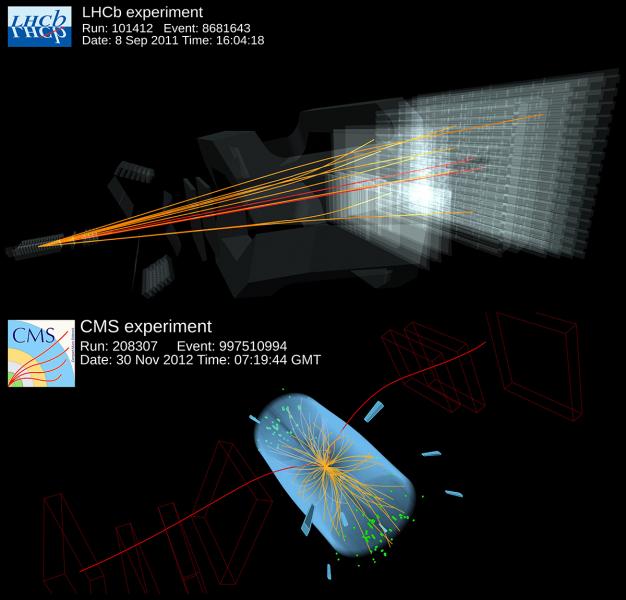May 15 2015
In an article published today in Nature, the CMS and LHCb collaborations describe the first observation of the very rare decay of the B0s particle into two muon particles.
 Event displays of a candidate B0s particle decaying into two muons in the LHCb detector (top - Image: LHCb/CERN) and in the CMS detector (bottom - Image: CMS/CERN)
Event displays of a candidate B0s particle decaying into two muons in the LHCb detector (top - Image: LHCb/CERN) and in the CMS detector (bottom - Image: CMS/CERN)
The Standard Model, the theory that best describes the world of particles, predicts that this rare subatomic process happens about four times out of a billion decays, but it has never been seen before. These decays are studied as they could open a window to theories beyond the Standard Model, such as supersymmetry. The analysis is based on data taken at the Large Hadron Collider (LHC) in 2011 and 2012. These data also contain early hints of a similar, but even more rare decay into two muons of the B0, a cousin of the B0s.
The B0s and B0 are mesons, in other words, non-elementary unstable subatomic particles composed of a quark and an antiquark, bound together by the strong interaction. Such particles are produced only in high-energy collisions – at particle accelerators, or in nature, for example in cosmic-ray interactions.
“This result is an excellent example of cooperation between different experiments and illustrates the impressive precision that can be reached when experiments combine their data”, said CERN Director General Rolf Heuer.
The two collaborations first released their individual results for B0s meson decay in July 2013. While the results were in excellent agreement, both fell just below the 5 sigma statistical precision historically needed to claim an observation. The combined analysis easily exceeds this requirement, reaching 6.2 sigma. This is the first time that CMS and LHCb have analysed their data together.
“It is testament to the excellent performance of the LHC, and the sensitivity of our experiments, that we have been finally able to observe this extremely rare but important decay”, said LHCb spokesperson Guy Wilkinson.
This exciting result is a major milestone in a search conducted by many experiments over almost three decades, and has important implications in the search for new particles and phenomena beyond the Standard Model, when the LHC physics run restarts in the next weeks.
“The search for new particles and the study of rare decays are complementary strategies for discovering new physics. The precision with which the experiments can measure these key decay rates will steadily improve, thus limiting the viable extensions to the Standard Model”, said CMS spokesperson Tiziano Camporesi.
The data to be gathered in future runs of the LHC will increase the precision of the B0s measurement and will determine whether the possible hints of the related decay of the B0 are confirmed. These results will be crucial for disentangling any signs of new phenomena from Standard Model effects and will advance the hunt for new physics.
Thousands of physicists at the LHC are engaged in a wide-ranging search for signs of new physics that might explain some of the biggest mysteries in science, including the nature of dark matter and why the universe, which started with equal numbers of matter and antimatter particles right after the Big Bang, is now composed mostly of matter with little antimatter left.